Primates: Homininae
Taxa on This Page
- Chororapithecus X
- Gorilla
- Gorillini
- Homininae
- Nakalipithecus X
- Pan
- Sahelanthropus X
- Samburupithecus X
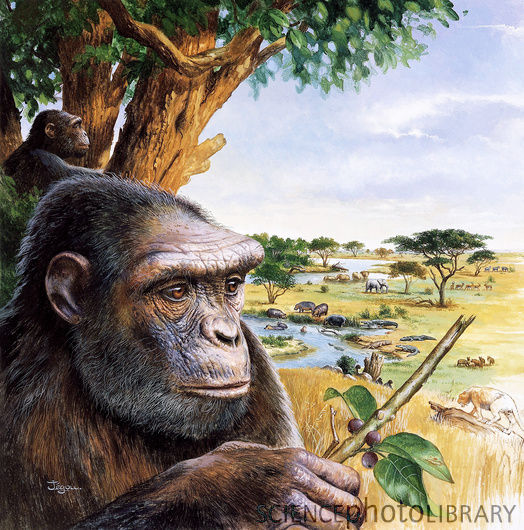
Sahelanthropus, life reconstruction. Late Miocene of Chad. This early hominid conrtains a mixture of primitive and advanced cahracteristics, and is a good candidate for a hominine ancestor, although its exact placement on the hominid tree remains uncertain. © Christian Jegou Publiphoto Diffusion/ Science Photo Library. |
Descriptions
Homininae African apes
Range: From the Late Miocene
Phylogeny: Hominidae : Dryopithecus + (Pierolapithecus + (Ponginae + * : Nakalipithecus + Samburupithecus + (Gorillini + (Sahelanthropus + (Pan + Hominini))
Comments One of the two major, geographic-based branches of Hominid (in older books Hominoid) evolution. The group underwent a rapid adaptive radiation during teh late Miocene, from which time a number of distinct lineages are known. None were ever very common, most species are known only from teeth and jaw and skull fragments. Although this group includes the two african great apes (chimps and gorillas), their fossil record is very poor or non-existent (the Miocene Chororapithecus is the only possible candidate to date) because acidic rainforest soils quickly dissolve bone and hence make fossilisation unlikely. This clade is also given the rank of family (Hominidae), although the current cladistic-based tendency is to use "Homininae". MAK120710
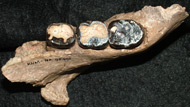
Nakalipithecus nakayamai
Phylogeny: Homininae :
Horizon: Late Miocene of Kenya
Comments Miocene and early Pliocene hominids seem to be mostly represented by rare fragmentary jawbones or isolated molars. Nakalipithecus is no different. The species was described from a fossil jawbone and eleven isolated teeth excavated in 2005 by a team of Japanese and Kenyan researchers in mud flow deposits in Nakali region of northern Kenya's Rift Valley Province hence the scientific name "Nakali ape". The fossil teeth were covered in thick enamel, suggesting that the diet of this hominoid included a considerable amount of hard objects, possibly nuts or seeds. Probably close to the common ancestor of chimps, gorillas and humans - from Wikipedia The discovery of Nakalipithecus less than 30 km (19 mi) from the Samburu area where another recently discovered ape, Samburupithecus, lived, shows that there were two different contemporary large hominids living in early late Miocene Kenya - Newsoftpedia, and if we include the contemporary Chororapithecus from nearby Ethiopia, known only from which may or may not be an ancestral gorilla, brings the tally to three hominines MAK120710
Image Nakalipithecus jawbone. Image credits: PNAS/National Academy of Sciences
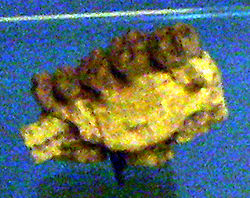
Samburupithecus kiptalami Ishida and Pickford, 1997
Phylogeny: Homininae :
Horizon: Late Miocene of Kenya
Characters: Defining cranial traits of this genus include low, broad zygomatics, straight alveolar process and large maxillary sinus. Defining dental traits include three-rooted premolars, thick enamel and buonodont cusps (Ward & Duren 2002). Unlike many other Miocene hominoids, Samburupithecus has teeth that are elongated from front to back. This feature links the taxon to gorillas, chimpanzees and hominins, but its relationships within this clade are presently unknown (Fleagle1999).
Comments known only from a maxilla fragment dated to 9.5 Ma discovered by Hidemi Ishida and Martin Pickford in 1997. Samburupithecus was approximately 60 kg and was most likely a frugivorus terrestrial quadruped (Fleagle1999). Paleoenvironmental reconstructions indicate that Samburupithecus most likely lived in a wooded habitat surrounded by savannah (Tsujikawa, 2005).
Image Samburupithecus kiptalami fossil, Muséum national d'histoire naturelle, Paris (Wikipedia)
References: above material from Wikipedia MAK111129
Gorillini King Kong > Viet Kong
Range: From the Late Miocene?, Africa
Phylogeny: Homininae : Nakalipithecus + Samburupithecus + ((Pan + Hominini) + * : Chororapithecus + Gorilla)
Comments Chororapithecus is tentatively included here
Chororapithecus abyssinicus Suwa et al 2007
Phylogeny: Gorillini : Gorilla + *
Horizon: Chorora Formation (Late Miocene), southern Afar of Ethiopia
Comments known only from nine teeth ( eight molars and a canine tooth) from a number of different individuals. The tooth morphology at the enamel-dentine junction gorilla-like, and size and form are also similar, so the paleontologists who discovered these fossils consider that Chororapithecus is an early member of the gorilla clade (Suwa, et al (2007)). However, their age, about 10 to 10.5 million years, is at least 2 million years earlier than the divergence date estimated by molecular phylogeny (8 million years ago for the last common ancestor between the human/chimpanzee lineage and gorillas). For this reason, and the fragmentary nature of the fossils, mean that their interpretation has been criticised, and similarities, if any, may be due to simple convergence. However a similar, and more irrefutable, disjunction between morphology and molecules is evident in eutherian mammal evolution, which means that molecular clock estimates are not necessarily reliable MAK120710
Link: A More Thorough Reading of the Chororapithecus abyssinicus paper
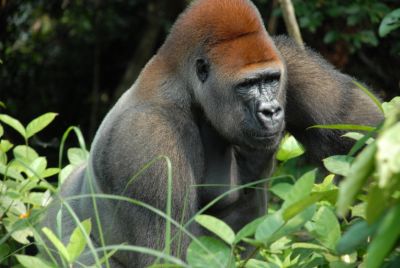
Gorilla Gorillas (what else?)
Range: Recent of Central Africa
Phylogeny: Gorillini : Chororapithecus + *
Comments the largest living primate, gorillas are ground-dwelling, herbivorous apes that inhabit the forests of central Africa , at a wide range of elevations, from lowlands to mountains. There are two species and either four or five subspecies, which seem to have developed from a single ancestor during the Pleistocene, when their forest habitats shrank and became isolated from each other. Dian Fossey's comprehensive study of the mountain gorilla dispelled charicatures and misconceptions about these creatures (Fossey, 1983). Social organisation is patriachal, with the dominant male, or silverback, at the center of the troop's attention, making all the decisions, mediating conflicts, determining the movements of the group, leading the others to feeding sites and taking responsibility for the safety and well-being of the troop.
Gorillas are highly intelligent with rich emotional lives; a few individuals, such as Koko, having been taught sign language. Gorillas have been shown to have cultures in different areas revolving around different methods of food preparation, and show individual color preferences. (Prince-Hughes, 1987)
Like all the great apes (apart from man) all the species and subspecies of gorilla are listed as either Endangered or Critically Endangered. Threats to gorilla survival include habitat destruction and poaching for the bushmeat trade. - adapted from Wikipedia
Image Silverback Western Gorilla (Gorilla gorilla), photograph by Pierre Fidenci Creative Commons Attribution Share Alike Wikipedia
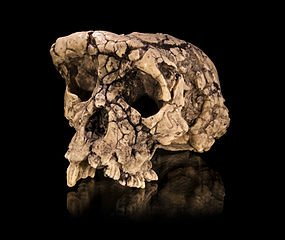
Sahelanthropus tchadensis Brunet et al., 2002 "Toumaï"
Phylogeny: Homininae : Nakalipithecus + Samburupithecus + (Gorillini + ((Pan + Hominini) + *)
Horizon: Late Miocene of Chad
Characters: mixture of derived and primitive features. The braincase, being only 320 cm³ to 380 cm³ in volume is similar to that of extant chimpanzees The teeth, brow ridges, and facial structure differ markedly from those found in Homo sapiens. Cranial features show a flatter face, u-shaped dental arcade, small canines, an anterior foramen magnum, and heavy brow ridges.
Comments Known from a partial cranium (named Toumaï, "hope of life" in the local Dazaga language of Chad), five pieces of jaw and some teeth. Dated to circa 7 million years, which predates the human-chimpanzee divergence (estimated to 6.3 to 5.4 million years ago according to the molecular clock). Whether Sahelanthropus tchadensis can be regarded as part of the Hominina tree is unclear. Since no postcranial remains have been discovered (although the femur of a hominid may have been discovered alongside the cranium but never published. (link)), it is as of yet unknown whether Sahelanthropus tchadensis was indeed bipedal, although claims for an anteriorly placed foramen magnum suggests that this may have been the case. The implication geree would be that modern knuckle-walkers descended from fully erect ancestors (see Filler 2007 )
Sahelanthropus may represent a common ancestor of humans and chimpanzees, or a form close to such an ancestor. Brigitte Senut and Martin Pickford, the discoverers of Orrorin tugenensis, suggested that the features of S. tchadensis are consistent with a female proto-gorilla. If S. tchadensis is an ancestral relative of the chimpanzees or gorillas, then it represents the first known member of their lineage. Unfortunately, the exact age of the fossil is somewhat hard to determine. Taphonomic analysis reveals the likelihood of one, perhaps two, burial(s) which seemingly occurred after the introduction of Islam in the region. Two other hominid fossils (a left femur and a mandible) were in the same "grave" along with various mammal remains.The sediment surrounding the fossils might thus not be the material the bones were originally deposited in. The fauna found at the site (the anthracotheriid Libycosaurus petrochii and the suid Nyanzachoerus syrticus) suggests an age of more than 6 million years
Image Cast of the Sahelanthropus tchadensis holotype cranium TM 266-01-060-1, dubbed Toumaï, in facio-lateral view. Specimen of of Anthropology Molecular and Imaging Synthesis of Toulouse. Photo by Didier Descouens (Wikipedia) Creative Commons Attribution Share Alike
References: above material adapted from Wikipedia, with a few modifications MAK111129
Pan chimps and bonobos
Range: Recent of central Africa
Phylogeny: Homininae : Nakalipithecus + Samburupithecus + (Gorillini + (Sahelanthropus + (Hominini + *))




